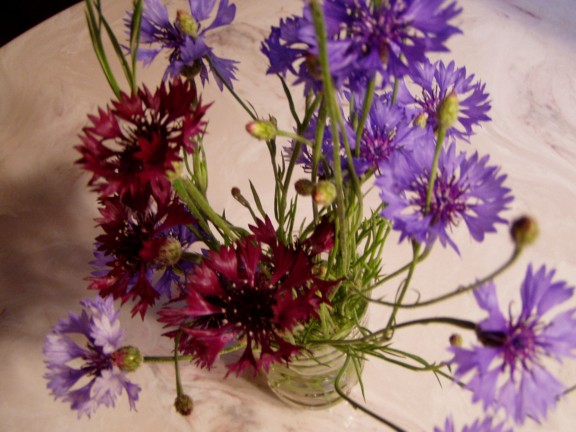|
Blue Cornflowers |
|
Purple and blue cornflowers found growing along side of Dogwalk Road in the Monroe community made a beautiful bouquet. |
|
On a drive in the country
recently, I happened to notice one of my favorite wildflowers growing by
the hundreds in a wheat field. This species is known as blue
cornflowers. Its presence canít be missed because of the intense blue
color of the blooms. Itís probably considered a weed by many, but I am
not included in that number. For those not familiar with cornflowers,
here is some information: Cornflowers are annual plants with grey-green
branched stems and were brought to America from Europe in the
seventeenth century. These flowers were among those cultivated by Thomas
Jefferson at Monticello. Often called the "cultivated weed" or "weed of
the cornfield", cornflower got its name because it was the flowering
weed that grew among the corn plants. The flowers are most commonly an
intense blue color, with a ring of a few large, spreading ray florets
surrounding a central cluster of disc florets. The blue pigment is
protocyanin, which in roses is red. In the past, it often grew as a weed
in crop fields. It is now said to be endangered in its native habitat
particularly through over-use of herbicides which destroy its habitat.
In the United Kingdom it has declined from 264 sites to just three sites
in the last 50 years. It is also however, through introduction as an
ornamental plant in gardens and a seed contaminant in crop seeds, now
naturalized in many other parts of the world, including North America
and parts of Australia. It is grown as an ornamental plant in gardens,
where several cultivars have been selected with varying pastel colors,
including pink and purple. Cornflowers have been used and prized
historically for their blue pigment. Cornflowers are often used as an
ingredient in tea and is famous in the Lady Grey blend of Twinings. In
folklore, cornflowers were worn by young men in love; if the flower
faded too quickly, it was taken as a sign that the man's love was There are also some magical uses for Cornflowers that include using
them for protection of property, to repel evil influences, and
discourage evil visitors. This is how you do it: Grind blue cornflowers
to a fine powder, then sweep your house with a broom. When your home is
thoroughly swept and spotless, sprinkle the powder over the threshold of
all doors which allow entry to the property. Also sprinkle it in the
corner of every room, including the corners of all your cupboards. Cornflowers were among the jewelry and gold discovered in the tomb of King Tutankhamen. A small wreath of cornflowers and olive leaves, still the deepest blue after thousands of years, was among the cache of riches left to aid the pharaoh in the afterlife. Prized for their intense blue color, cornflowers have been featured in gardens for more than a hundred years. Most varieties are blue, but others come in pink, maroon, and white blooms, set apart by pale, gray-green leaves. Another name for Corn Flowers is Bachelor's buttons that grow one to three feet and bloom in early summer. Leave some seed heads after these annuals flower and goldfinches will visit your garden to eat the seeds. Bachelor's buttons last for up to two weeks as a cut flower and they are also nice dried. I was happy to have the opportunity to pick a bouquet of cornflowers the other day and was very surprised to find purple ones growing along side the blue ones. I placed that little bouquet in a plastic water bottle I happened to have in the car, and continued to enjoy its beauty for many days. A quote from Robert Louis Stevenson points out how the simple things in life are what really counts. Hereís what he recommends: "The best things in life are nearest: Breath in your nostrils, light in your eyes, flowers at your feet, duties at your hand, the path of right just before you. Then do not grasp at the stars, but do life's plain, common work as it comes, certain that daily duties and daily bread are the sweetest things in life."
|
